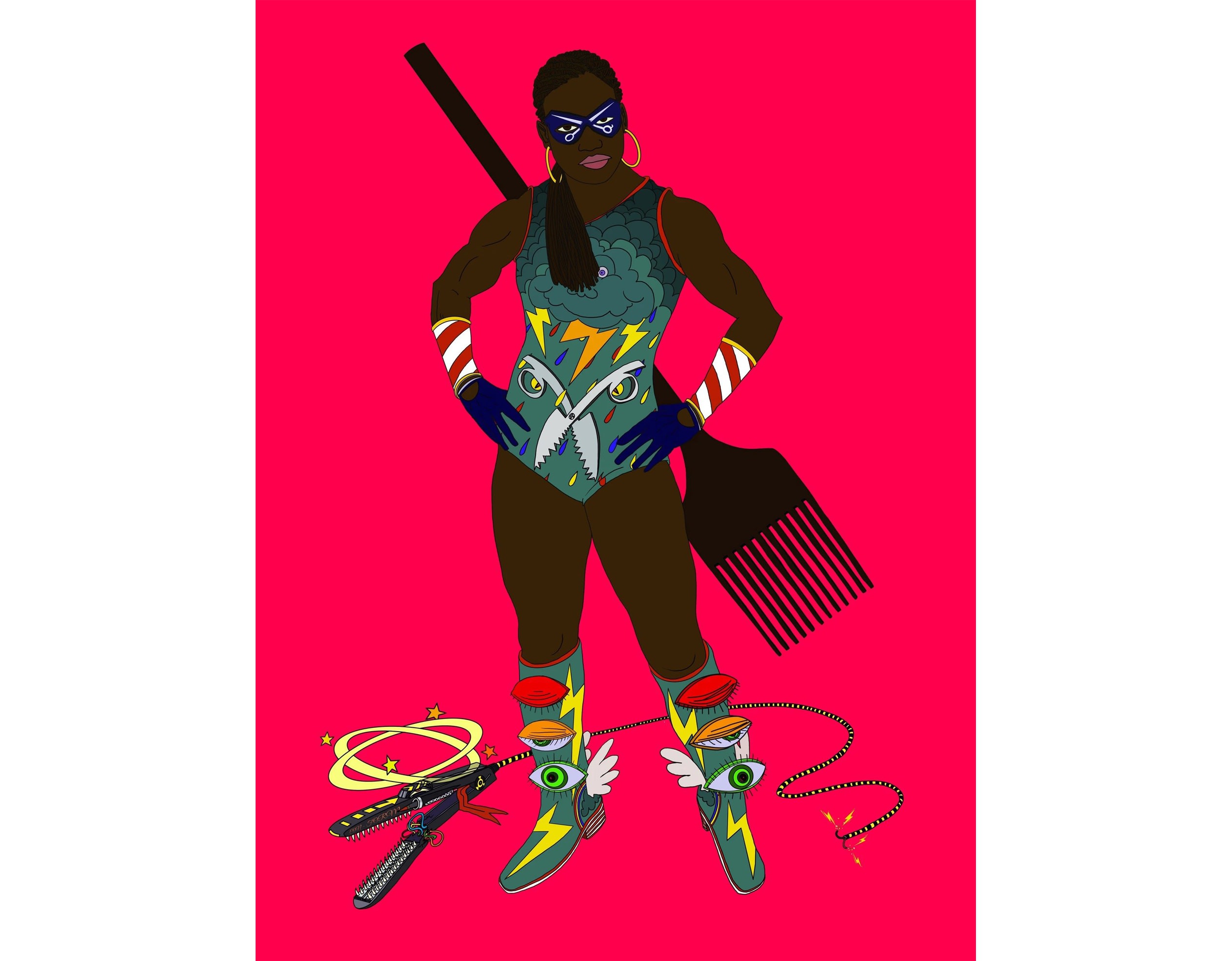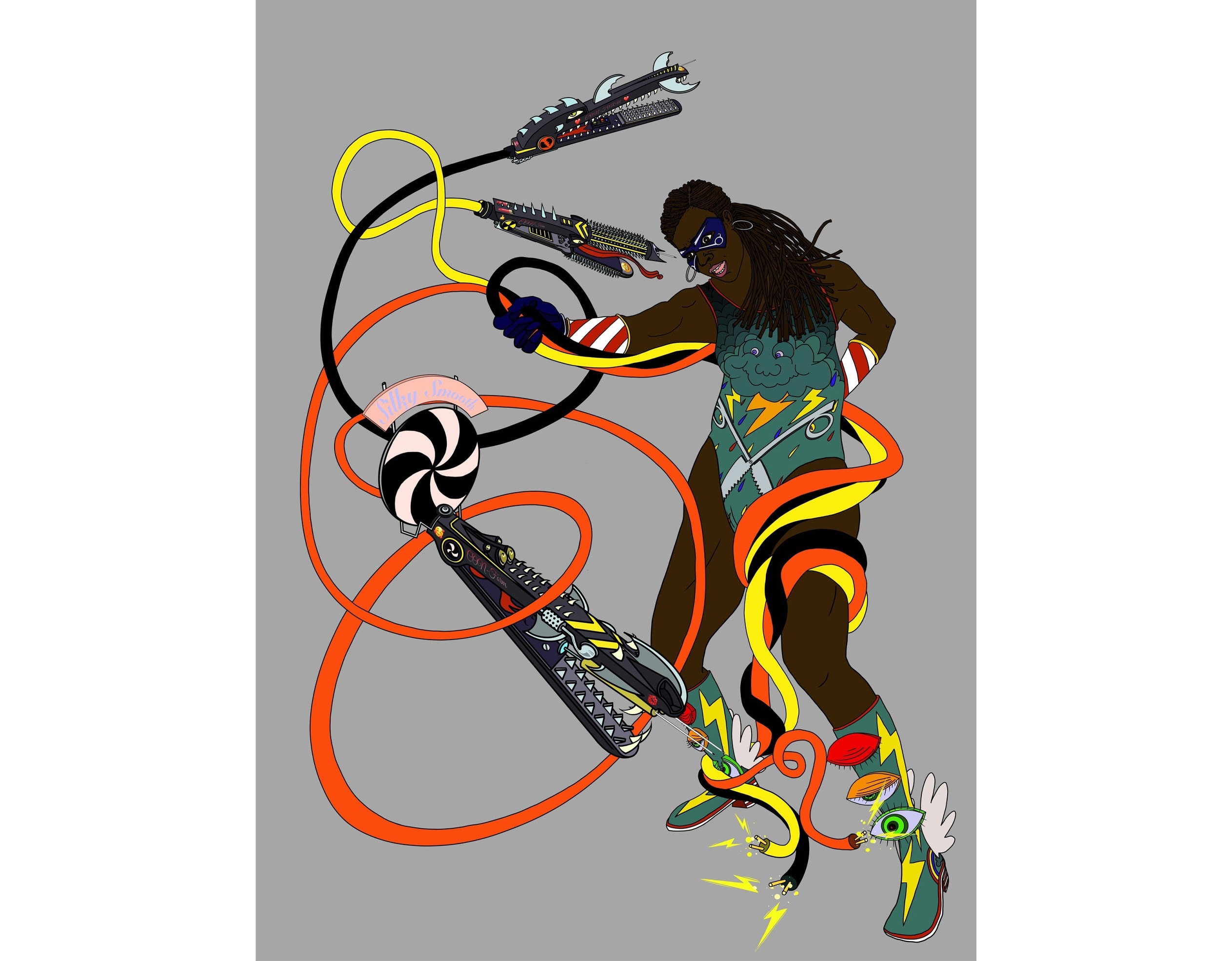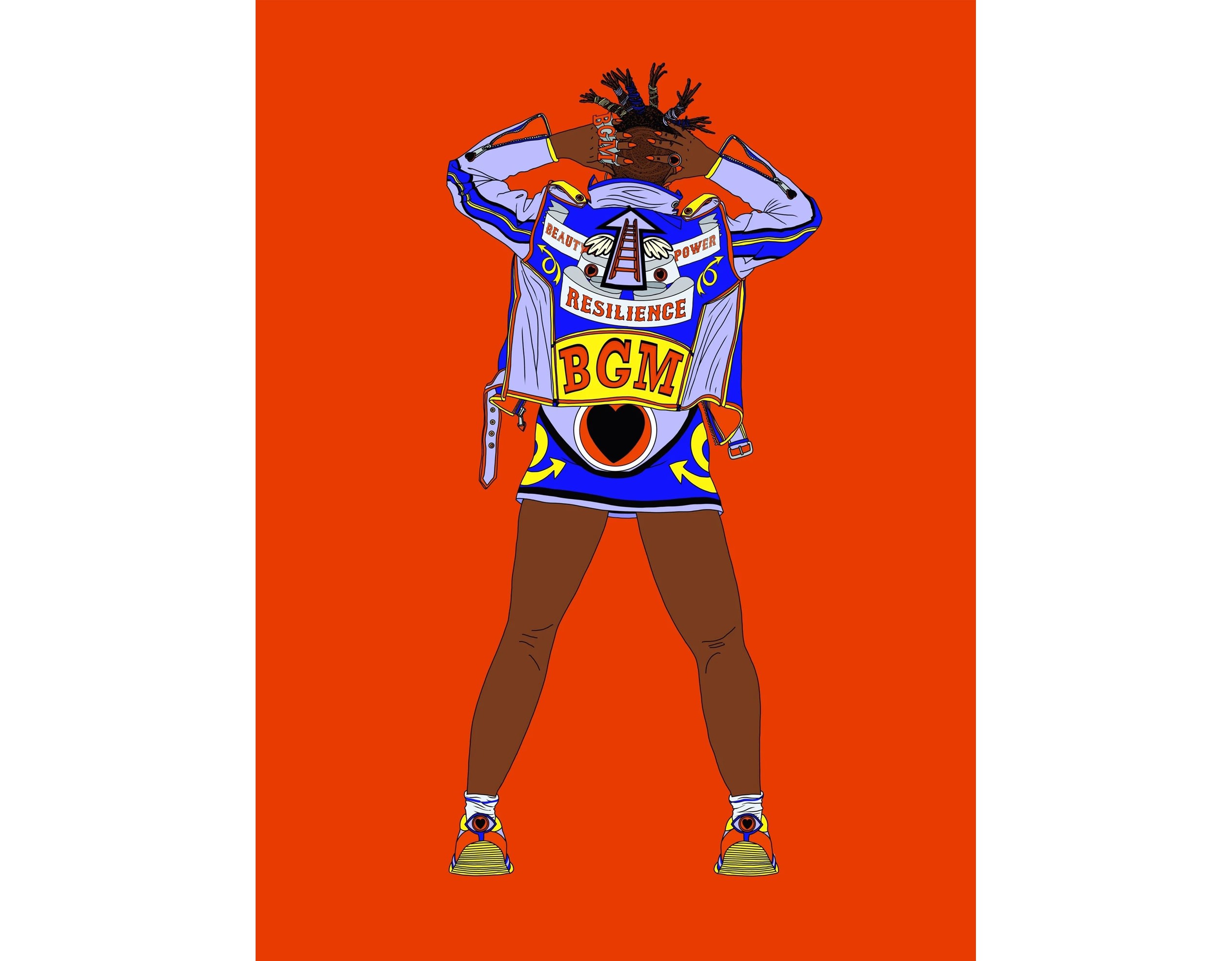Since graduating from Printmaking at the Royal College of Art, London in 2000, Professor Peter Lloyd ARE has exhibited extensively in the UK and significantly in Europe, China and the USA. In addition to practicing as an artist, Peter is also the Dean of Faculty for the Creative Industries, Architecture and Engineering at Solent University, Southampton, UK.
Well known for his screen printed Mexican wrestler images, Peter's current body of work explores black culture and the diverse world of Afrofuturism through the pop culture lens of the super hero. We were thrilled to catch up with Peter to talk about his background, creative process, inspiration and love for drawing and printmaking. We also found out more about the concept of Afrofuturism and his recent body of work, 'Heroes and Villains'.
Interview: Matilda Barratt in conversation with Peter Lloyd ARE.
Could you start by telling us a bit about who you are and what you do?
"I’m in the very privileged position of leading a Creative Faculty in a very forward looking and innovative institution; Southampton Solent University. I’m incredibly lucky to be surrounded by knowledgeable staff, passionate students and a whole range of traditional and cutting edge pieces of kit. It’s such a dynamic and inspiring environment to be in, I love it and I thrive in it. I’m proud to be representing the University as a partner in Southampton’s City of Culture bid 2025 and I am incredibly proud to be co-Chairing the University’s application for Race Equality Charter status. I draw, print, paint and have become increasingly interested in the creation of digital imagery and the applications of that work in terms of printing. I’m a school Governor and I write songs and sing in a band called ‘The Postmen’. In addition to this I’m a husband and a father to 2 beautiful and constantly surprising kids, a girl and a boy. It sounds like an eclectic mix of too many things to do, but I see all these things as clearly connected and feeding into and off one another. Fairness, creativity, calculated risk taking and generosity of spirit run through everything I do."
I understand that you started your working life as an apprentice sheet metal worker at Liverpool docks?
"I would love to say I was a Docker, in terms of kudos it’s up there with ‘Footballer’ in my home town. My Da (my Mother’s Father) was a Docker, so I grew up close to the fantastic stories and the incredibly clever workplace nicknames, but I was never employed as a Docker. I did however undertake a sheet metal work apprenticeship that started in a workshop on Scotland Road in Liverpool; a glorious road with an incredible place in Liverpool’s history and folklore. The workshop grew and because the majority of work related to shipping we moved to the Dock Road area; another fantastic environment full of rich histories, gentle hard knocks and natural born entertainers. Given all the ships that were travelling in and out of the port from around the world it was a very international community too- I always loved that aspect of the scene. Most of the crew members were coming off 3 or 6 month journeys at sea, so a whole infrastructure of very late night bars and personal services were created on the road to cater to their needs. It was a very raucous, sometimes dangerous and incredibly exciting place to be. So I can’t make a legitimate claim to the title ‘Docker’, but I was on the periphery of it all. ‘Plastic Docker’ might be more fitting, I’d take that."

Did this influence your work later down the line? How did you come to do what you do today?
"The stories and the characters; the folk and the folklore definitely inspired, and continues to inspire my work. The job itself became repetitive and boring, which in itself was inspiring; it was that need to escape mediocrity that drove me to make a radical change to the course of my life. I had always drawn, but only for entertainment, I’d never considered it as a career option. Liverpool has a huge student population and I fell in with a really interesting crowd of people of my age, from very different parts of the country and set on what seemed to be very different and exciting paths to the one I’d found myself on. I remember visiting their shared house in Toxteth, Liverpool, it was like a beautifully squalid advent calendar with a rich treat waiting behind every door; behind one door was a Student studying Classics, another studying Chemistry, another writing an essay about surrealism and behind another somebody trying to get their head around Genetics. I was cynical at first; where was the money in that? But one day the penny just dropped for me, they were on a voyage of discovery about something they were passionate about. I found myself really wanting that for myself, but just felt as though University wasn’t for the likes of me. There was a whole other world out there for the taking and the route into it was education. I sold my Ford Escort and my impressive range of designer shell suits and enrolled onto an Art Foundation course. I had no clear long term goals or aspirations, I just wanted to get on that journey and improve. I’m still on that journey today and I get tremendous satisfaction from helping others access and succeed on the very same route."
What was it that first attracted you to printmaking?
"I had stories to tell about people and places and I wanted to tell those stories in a figurative way. I was accepted onto the Painting Degree at Winchester School of Art, but unfortunately for me it was the early 90’s and installation and conceptual art was de rigueur. I went with it for 3 months but soon discovered that downstairs in the Etching baths, on the litho stones and across the screen printing beds, narratives were being told in a way that retained the traditional but also complemented it with the new; the baby hadn’t been thrown out with the bath water. This felt like a natural home for me, so I transferred onto the Printmaking course and haven’t looked back since. I like the fact that there is an element of process and technique to understand and I enjoy being in an environment that feels industrial. I was attracted to the graphic nature of the discipline and I was particularly drawn to the possibility of making works that exist in multiples, that could be shared and that could exist in more than one place at any given time. Prints are like time lords."
Does drawing play an important role in your life and your practice?
"Very much so, everything starts with drawing for me. Drawing has been a solid friend to me throughout my life, even before I recognised it as such. Drawing makes me laugh, calms me down, gets me angry, helps me explore and unpick ideas, fills in the voids of monotonous telephone calls and Zoom meetings and allows me to communicate complex ideas in a direct and simple way. Drawing is a friend I can turn to in any situation, it’s never let me down. Prints are more faithful than dogs."

I’m interested to find out a little bit about your creative process. Where do you find inspiration? How do you typically go from an idea to something tangible?
"I love art that imitates or is informed by life. Making art for me is about experiencing something personally and then communicating it visually. It’s also about encountering something first hand that you might perhaps find difficult to understand or process, making art is a great way to research and unpick those problems. You can only make something tangible and coherent if you have attempted to understand it in the first place. This for me is the difference between ‘good’ and ‘bad’ art. I try to understand through drawing, then I make statements through print."
Is there something that you hope to capture or convey with your work?
"My work is like an open diary for people to read, it’s very biographical. My early work was very accessible, commercial and fun. My recent work is still all of those things but less frivolous I would say. I still want to draw people in, but once I’ve got them I hope to engage them in a deeper conversation or provide them with some food for thought."
Have you found that your creative process has changed at all over the past few months? Has the lockdown affected your relationship to drawing and making at all?
"As I’ve been working with digital drawing and print I haven’t experienced much disruption. I received a commission from Southampton City Council during lockdown to customise a bench for the central High St. in the city. They provided me with the relevant dimensions which I used to create digital canvases on my iPad Pro. Once complete the digital files where emailed to a local print company who had sourced an adhesive substrate which could accept high quality print and withstand the daily wear and tear a bench might experience. These prints were then wrapped around the bench parts, delivered back to the Council and installed. At no point in the process did I have any contact or interaction with the physical object? A scary, liberating, non-traditional, forward looking and extremely interesting way to work! The bench was a collaboration with Race and Equality expert Don John and used the Reverend Jesse Jackson quote ‘I am somebody’ as it’s central theme. Working in collaboration with others is another approach that I have developed in my later work. Working in isolation still has a strong attraction for me, but there is also much to gain from the insight and influence of another, particularly if you’re making work outside of your lived experience."

I am eager to find out more about your current body of work. What is 'Afrofuturism', and what inspired you to explore it in your own work?
"Solent Showcase Gallery is part of the Art School I manage and through its visionary curator, Kate Maple, we connect to the people of the city we operate in. Kate curated an incredible show called ‘Black to the Future’, which introduced me to the concept of Afrofuturism; the realisation that not only had black people been omitted from much of world history, they were also being omitted from the fictional futures described in the science fiction diaspora. Artists such as the fantastic printmaker Ade Adesina ARE are addressing this situation by creating images that feature a future where black people do exist. The same is happening across music, literature and film. Based on this discovery and primarily driven by the urge to understand and convey various experiences with my own family (my wife is of Jamaican parentage and my children are dual heritage) I felt a very strong urge to contribute to this movement."
So could you tell us a little more about ‘Heroes and Villains’? What are you trying to achieve with this body of work, and why is it so important?
"‘Heroes and Villains’ at the Jackhouse Gallery, Portsmouth was my first response to experiencing ‘Black to the Future’ at the Solent Showcase Gallery. This body of prints allowed me to explore issues my family and I had experienced personally, to better understand issues that I was aware of associated with black culture and to hopefully discover issues that I was completely unaware of. By then exhibiting the work and sharing my new knowledge and observations through workshops, public presentations, conversations and social media my aim was to platform and broadcast my observations to others. The work dealt with difficult, sometimes horrendous issues, but it also celebrated positive issues and highlighted achievements that are overlooked or little known. The show dealt with these negative and positive aspects through the super hero model, hence some of the supers are heroes and others are most definitely villains.
"I discussed my early work with a cultural leader in Southampton who after considering the work warned me that I should at all costs avoid preaching to communities; ‘We don’t need another ‘White Saviour’ to try and show us the way, Peter’. This was great advice, a lot of the areas I was exploring were not part of my lived life, I’m white and very privileged. So I was mindful that my approach to the prints had to be that of an ally in a supporting role who was using his privilege to unpick rather than underpin whiteness. This body of work was about me trying to better understand some of the issues and using my platform and abilities to broadcast my findings and start some conversations. I was also very aware that a lot of imagery relates to being black in America, I made a conscious decision to set my prints within a black British universe.
"I wanted to be sure that my train of thought and resulting outputs had authenticity to them, to ensure this I reached out to Don John as a navigator and educator. This relationship has developed into something that I value very much and I look forward to hatching further plans in collaboration with Don, probably while sat on our bench in Southampton High St."

Do you have any words of wisdom for young aspiring creatives who believe that a career in the art world is out of reach?
"Being an artist gives you a legitimate excuse to access and understand worlds that are outside of your own. Like a journalist with a media pass, your sketchbook can allow you to get behind the scenes of some incredible lives and situations. Have some fun, but never lose sight of the fact that being an artist is a fantastically privileged position to be in that can afford you greater understanding of others and betterment of yourself. Whatever your goal is I can categorically tell you that it is not out of your reach. There will be obstacles, no doubt about that, but you should not deny yourself the opportunity to try- your ally’s and accomplices are out there to support you! As Don taught me and as the Rev. Jesse Jackson said, ‘no matter what anyone else says, you are Somebody’."
To view Peter's latest exhibition, Heroes & Villains, click here.
If you were inspired by this interview with Peter and would like to keep up with his work, you can follow him on Instagram: @peterlloyd68
More like this on the Blog...
Read: Interview with Akash Bhatt
Read: Interview with Richard Pikesley
Read: Interview with Sumi Perera
Read: The Poetry of the Everyday: Interview with Anita Klein
Read: Frank Kiely RE: Sketches in Lockdown
